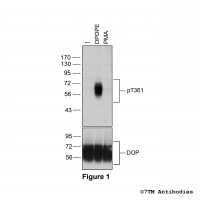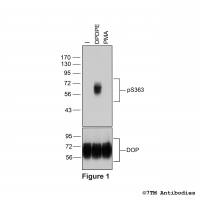No results were found for the filter!
NEW
 pS338/pS339-DP2 (phospho-DP2 Prostanoid...
pS338/pS339-DP2 (phospho-DP2 Prostanoid... Serine338/Serine339 (S338/S339) is major phosphorylation site of the DP2 Prostanoid Receptor (DP2). The pS338/pS339-DP2 antibody detects phosphorylation in response to agonists. S338/S339 phosphorylation is likely to be involved in...
$ 375.00 *
NEW
 pT344/pS345-DP2 (phospho-DP2 Prostanoid...
pT344/pS345-DP2 (phospho-DP2 Prostanoid... Threonine344/Serine345 (T344/S345) is major phosphorylation site of the DP2 Prostanoid Receptor (DP2). The pT344/pS345-DP2 antibody detects phosphorylation in response to agonists. T344/S345 phosphorylation is likely to be involved in...
$ 375.00 *
NEW
 pS493/pS495-PTH1 (phospho-Parathyroid Hormone...
pS493/pS495-PTH1 (phospho-Parathyroid Hormone... Serine493/Serine495 (S493/S495) is major phosphorylation site of the Parathyroid Hormone Receptor 1 (PTH1). The pS493/pS495-PTH1 antibody detects phosphorylation in response to agonists. S493/S495 phosphorylation is likely to be involved...
$ 375.00 *
NEW
 pT503/pS504-PTH1 (phospho-Parathyroid Hormone...
pT503/pS504-PTH1 (phospho-Parathyroid Hormone... Threonine503/Serine504 (T503/S504) is major phosphorylation site of the Parathyroid Hormone Receptor 1 (PTH1). The pT503/pS504-PTH1 antibody detects phosphorylation in response to agonists. T503/S504 phosphorylation is likely to be...
$ 375.00 *
NEW
 pS323-P2Y12 (phospho-P2Y Purinoceptor 12 Antibody)
pS323-P2Y12 (phospho-P2Y Purinoceptor 12 Antibody) Serine323 (S323) is a major phosphorylation site of the P2Y12 receptor. The pS323-P2Y12 antibody detects phosphorylation in response to high- and low-efficacy agonists and after PKC activation. S323 phosphorylation is a key regulator of...
$ 375.00 *
NEW
 pS344/pS345-P2Y4 (phospho-P2Y Purinoceptor 4...
pS344/pS345-P2Y4 (phospho-P2Y Purinoceptor 4... Serine344/Serine345 (S344/S345) is a major phosphorylation site of the P2Y4 receptor. The pS344/pS345-P2Y4 antibody detects phosphorylation in response to high- and low-efficacy agonists and after PKC activation. S344/S345...
$ 375.00 *
NEW
 pS339-P2Y4 (phospho-P2Y Purinoceptor 4 Antibody)
pS339-P2Y4 (phospho-P2Y Purinoceptor 4 Antibody) Serine339 (S339) is a major phosphorylation site of the P2Y4 receptor. The pS339-P2Y4 antibody detects phosphorylation in response to high- and low-efficacy agonists and after PKC activation. S339 phosphorylation is a key regulator of...
$ 375.00 *
NEW
 pT351-P2Y4 (phospho-P2Y Purinoceptor 4 Antibody)
pT351-P2Y4 (phospho-P2Y Purinoceptor 4 Antibody) Threonine351 (T351) is a major phosphorylation site of the P2Y4 receptor. The pT351-P2Y4 antibody detects phosphorylation in response to high- and low-efficacy agonists and after PKC activation. T351 phosphorylation is a key regulator of...
$ 375.00 *
NEW
 pS343-GPR183 (phospho-GPR183 Antibody)
pS343-GPR183 (phospho-GPR183 Antibody) Serine343 (S343) is major phosphorylation site of human GPR183 receptor. The pS343-GPR183 antibody detects phosphorylation in response to agonists. S343 phosphorylation is likely to be involved in efficient ligand sequestration by GPR183.
$ 375.00 *
NEW
 pT347/pT349-GPR183 (phospho-GPR183 Antibody)
pT347/pT349-GPR183 (phospho-GPR183 Antibody) Threonine347/threonine349 (T347/T349) is major phosphorylation site of human GPR183 receptor. The pT347/pT349-GPR183 antibody detects phosphorylation in response to agonists. T347/T349 phosphorylation is likely to be involved in...
$ 375.00 *
NEW
 pS355-GPR183 (phospho-GPR183 Antibody)
pS355-GPR183 (phospho-GPR183 Antibody) Serine355 (S355) is major phosphorylation site of human GPR183 receptor. The pS355-GPR183 antibody detects phosphorylation in response to agonists. S355 phosphorylation is likely to be involved in efficient ligand sequestration by GPR183.
$ 375.00 *
Citations
 pT361-DOP (phospho-∂-Opioid Receptor Antibody)
pT361-DOP (phospho-∂-Opioid Receptor Antibody) Threonine361 (T361) is a major phosphorylation site of the delta-opioid receptor (DOP). The pT361-DOP antibody detects phosphorylation in response to agonists but not after PKC activation. T361 phosphorylation is a key regulator of DOP...
$ 375.00 *
Citations
 pS363-DOP (phospho-∂-Opioid Receptor Antibody)
pS363-DOP (phospho-∂-Opioid Receptor Antibody) Serine363 (S363) is the primary phosphorylation site in a hierarchical phosphorylation cascade of the delta-opioid receptor (DOP). The pS363-DOP antibody detects phosphorylation in response to high- and low-efficacy agonists but not...
$ 375.00 *
NEW
 DOP (non-phospho) ∂-Opioid Receptor Antibody
DOP (non-phospho) ∂-Opioid Receptor Antibody The non-phospho-∂-opioid receptor antibody is directed against the distal end of the carboxyl-terminal tail of mouse, rat and human DOP. It can be used to detect total DOP receptors in Western blots independent of phosphorylation.
$ 300.00 *
NEW
 pT358/pT361-DOP (phospho-∂-Opioid Receptor...
pT358/pT361-DOP (phospho-∂-Opioid Receptor... Threonine358/Threonine361 (T358/T361) is the primary phosphorylation site in a hierarchical phosphorylation cascade of the delta-opioid receptor (DOP). The pT358/T361-DOP antibody detects phosphorylation in response to high- and...
$ 375.00 *
NEW
 pT361/pS363-DOP (phospho-∂-Opioid Receptor...
pT361/pS363-DOP (phospho-∂-Opioid Receptor... Threonine361/Serine363 (T361/S363) is the primary phosphorylation site in a hierarchical phosphorylation cascade of the delta-opioid receptor (DOP). The pT361/pS363-DOP antibody detects phosphorylation in response to high- and...
$ 375.00 *
Recently viewed


